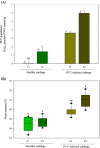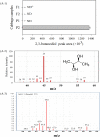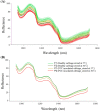Nondestructive classification of soft rot disease in napa cabbage using hyperspectral imaging analysis
- PMID: 36038711
- PMCID: PMC9424267
- DOI: 10.1038/s41598-022-19169-6
Nondestructive classification of soft rot disease in napa cabbage using hyperspectral imaging analysis
Abstract
Identification of soft rot disease in napa cabbage, an essential ingredient of kimchi, is challenging at the industrial scale. Therefore, nondestructive imaging techniques are necessary. Here, we investigated the potential of hyperspectral imaging (HSI) processing in the near-infrared region (900-1700 nm) for classifying napa cabbage quality using nondestructive measurements. We determined the microbiological and physicochemical qualitative properties of napa cabbage for intercomparison of HSI information, extracted HSI characteristics from hyperspectral images to predict and classify freshness, and established a novel approach for classifying healthy and rotten napa cabbage. The second derivative Savitzky-Golay method for data preprocessing was implemented, followed by wavelength selection using variable importance in projection scores. For multivariate data of the classification models, partial least square discriminant analysis (PLS-DA), support vector machine (SVM), and random forests were used for predicting cabbage conditions. The SVM model accurately distinguished the cabbage exhibiting soft rot disease symptoms from the healthy cabbage. This study presents the potential of HSI systems for separating soft rot disease-infected napa cabbages from healthy napa cabbages using the SVM model, especially under the most effective wavelengths (970, 980, 1180, 1070, 1120, and 978 nm), prior to processing. These results are applicable to industrial multispectral images.
© 2022. The Author(s).
Conflict of interest statement
The authors declare no competing interests.
Figures





References
-
- Perombelon MCM. Potato diseases caused by soft rot erwinias: an overview of pathogenesis. Plant Pathol. 2002;51:1–12. doi: 10.1046/j.0032-0862.2001.Shorttitle.doc.x. - DOI
-
- Tsror (Lahkim) et al. Characterization of Pectobacterium brasiliense strains from potato and vegetables in Israel. Plant Pathol.70, 2179–2187. 10.1111/ppa.13454 (2021).
-
- Yang, J.S., Lee, H.W., Song, H. & Ha, J.-H. Volatile metabolic markers for monitoring Pectobacterium carotovorum subsp. carotovorum using headspace solid-phase microextraction coupled with gas chromatography-mass spectrometry. J. Microbiol. Biotechnol.31, 70–78. 10.4014/jmb.2009.09028 (2021). - PMC - PubMed
-
- Hadas, R., Kritzman, G., Gefen, T. & Manulis, S. Detection, quantification and characterization of Erwinia carotovora ssp. carotovora contaminating pepper seeds. Plant Pathol.50, 117–123. 10.1046/j.1365-3059.2001.00540.x (2001).
Publication types
MeSH terms
LinkOut - more resources
Full Text Sources
Miscellaneous

